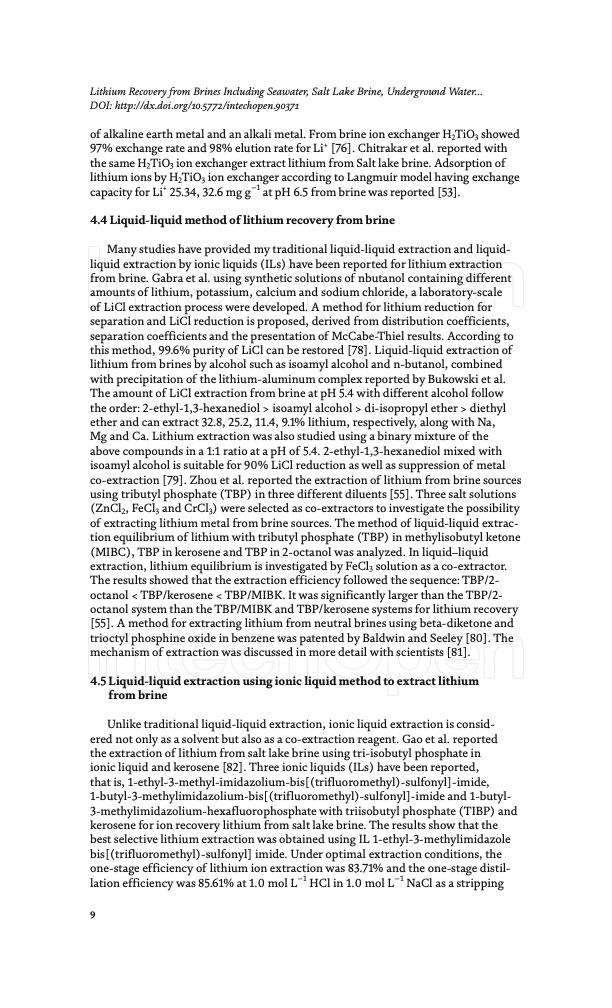
PDF Publication Title:
Text from PDF Page: 011
Lithium Recovery from Brines Including Seawater, Salt Lake Brine, Underground Water... DOI: http://dx.doi.org/10.5772/intechopen.90371 of alkaline earth metal and an alkali metal. From brine ion exchanger H2TiO3 showed 97% exchange rate and 98% elution rate for Li+ [76]. Chitrakar et al. reported with the same H2TiO3 ion exchanger extract lithium from Salt lake brine. Adsorption of lithium ions by H2TiO3 ion exchanger according to Langmuir model having exchange capacity for Li+ 25.34, 32.6 mg g−1 at pH 6.5 from brine was reported [53]. 4.4 Liquid-liquid method of lithium recovery from brine Many studies have provided my traditional liquid-liquid extraction and liquid- liquid extraction by ionic liquids (ILs) have been reported for lithium extraction from brine. Gabra et al. using synthetic solutions of nbutanol containing different amounts of lithium, potassium, calcium and sodium chloride, a laboratory-scale of LiCl extraction process were developed. A method for lithium reduction for separation and LiCl reduction is proposed, derived from distribution coefficients, separation coefficients and the presentation of McCabe-Thiel results. According to this method, 99.6% purity of LiCl can be restored [78]. Liquid-liquid extraction of lithium from brines by alcohol such as isoamyl alcohol and n-butanol, combined with precipitation of the lithium-aluminum complex reported by Bukowski et al. The amount of LiCl extraction from brine at pH 5.4 with different alcohol follow the order: 2-ethyl-1,3-hexanediol > isoamyl alcohol > di-isopropyl ether > diethyl ether and can extract 32.8, 25.2, 11.4, 9.1% lithium, respectively, along with Na, Mg and Ca. Lithium extraction was also studied using a binary mixture of the above compounds in a 1:1 ratio at a pH of 5.4. 2-ethyl-1,3-hexanediol mixed with isoamyl alcohol is suitable for 90% LiCl reduction as well as suppression of metal co-extraction [79]. Zhou et al. reported the extraction of lithium from brine sources using tributyl phosphate (TBP) in three different diluents [55]. Three salt solutions (ZnCl2, FeCl3 and CrCl3) were selected as co-extractors to investigate the possibility of extracting lithium metal from brine sources. The method of liquid-liquid extrac- tion equilibrium of lithium with tributyl phosphate (TBP) in methylisobutyl ketone (MIBC), TBP in kerosene and TBP in 2-octanol was analyzed. In liquid–liquid extraction, lithium equilibrium is investigated by FeCl3 solution as a co-extractor. The results showed that the extraction efficiency followed the sequence: TBP/2- octanol < TBP/kerosene < TBP/MIBK. It was significantly larger than the TBP/2- octanol system than the TBP/MIBK and TBP/kerosene systems for lithium recovery [55]. A method for extracting lithium from neutral brines using beta-diketone and trioctyl phosphine oxide in benzene was patented by Baldwin and Seeley [80]. The mechanism of extraction was discussed in more detail with scientists [81]. 4.5 Liquid-liquid extraction using ionic liquid method to extract lithium from brine Unlike traditional liquid-liquid extraction, ionic liquid extraction is consid- ered not only as a solvent but also as a co-extraction reagent. Gao et al. reported the extraction of lithium from salt lake brine using tri-isobutyl phosphate in ionic liquid and kerosene [82]. Three ionic liquids (ILs) have been reported, that is, 1-ethyl-3-methyl-imidazolium-bis[(trifluoromethyl)-sulfonyl]-imide, 1-butyl-3-methylimidazolium-bis[(trifluoromethyl)-sulfonyl]-imide and 1-butyl- 3-methylimidazolium-hexafluorophosphate with triisobutyl phosphate (TIBP) and kerosene for ion recovery lithium from salt lake brine. The results show that the best selective lithium extraction was obtained using IL 1-ethyl-3-methylimidazole bis[(trifluoromethyl)-sulfonyl] imide. Under optimal extraction conditions, the one-stage efficiency of lithium ion extraction was 83.71% and the one-stage distil- lation efficiency was 85.61% at 1.0 mol L−1 HCl in 1.0 mol L−1 NaCl as a stripping 9PDF Image | Lithium Recovery from Seawater Salt Lake Brine

PDF Search Title:
Lithium Recovery from Seawater Salt Lake BrineOriginal File Name Searched:
IntechOpenSamadiyBookchapter.pdfDIY PDF Search: Google It | Yahoo | Bing
Product and Development Focus for Infinity Turbine
ORC Waste Heat Turbine and ORC System Build Plans: All turbine plans are $10,000 each. This allows you to build a system and then consider licensing for production after you have completed and tested a unit.Redox Flow Battery Technology: With the advent of the new USA tax credits for producing and selling batteries ($35/kW) we are focussing on a simple flow battery using shipping containers as the modular electrolyte storage units with tax credits up to $140,000 per system. Our main focus is on the salt battery. This battery can be used for both thermal and electrical storage applications. We call it the Cogeneration Battery or Cogen Battery. One project is converting salt (brine) based water conditioners to simultaneously produce power. In addition, there are many opportunities to extract Lithium from brine (salt lakes, groundwater, and producer water).Salt water or brine are huge sources for lithium. Most of the worlds lithium is acquired from a brine source. It's even in seawater in a low concentration. Brine is also a byproduct of huge powerplants, which can now use that as an electrolyte and a huge flow battery (which allows storage at the source).We welcome any business and equipment inquiries, as well as licensing our turbines for manufacturing.| CONTACT TEL: 608-238-6001 Email: greg@infinityturbine.com | RSS | AMP |